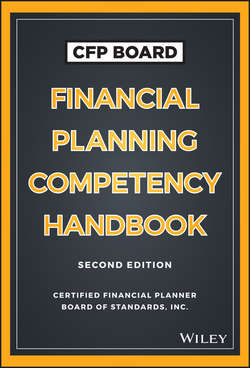Читать книгу CFP Board Financial Planning Competency Handbook - Board CFP - Страница 14
На сайте Литреса книга снята с продажи.
PART One
Introduction
CHAPTER 1
Theory and Practice
IN CLASS 16
ОглавлениеOne of the general objectives in education is to facilitate learning at higher cognitive levels. The idea here is that if learning takes place where the student is applying and creating, then these new skills will be generalizable beyond just the context of that given skill. If the learner is only remembering and regurgitating facts, then he or she may remember them long enough to take a test or recite something, but forget them or have difficulty applying them to other contexts.
Bloom’s Taxonomy17 was developed not only as an effective measurement tool for student learning, but also as a way to develop common language regarding learning goals and curriculum development across multiple instructors relative to a given subject area.18 Bloom’s Taxonomy also provides the opportunity to explore the depth to which a given subject area can be studied. Updated in 2002, Bloom’s Taxonomy consists of the following levels relative to the cognitive domain:19
Remember: Remembering, the least complex of the categories, is a process of storing and retrieving knowledge from long-term memory through processes such as recognizing or recalling relevant facts or attributes.
Understand: The next category, understanding, involves determining the meaning of instructional messages and communication, including oral, written, and graphic messages. This can include classifying, summarizing, or explaining a given text or communication.
Apply: Applying is the process of using or carrying out a procedure in a given situation. This can involve executing or implementing a system or procedure for a new context or set of facts.
Analyze: Analyzing involves breaking material down, identifying how its constituent parts relate to one another, and identifying how these parts relate to an overall structure or purpose, including differentiating and organizing the material.
Evaluate: Evaluating is the process of taking criteria and standards and using them to make judgments or assessments. This involves drawing on a set of criteria to check or critique material.
Create: Creating involves the formation of an original product or a novel, coherent whole by combining elements or putting them together. This includes generating, planning, or producing new material.
The In Class sections of Chapters 2 to 70 note the learning experiences and assessment possibilities for facilitating higher-order cognitive thinking in the financial planning classroom. These tables should assist faculty in developing class activities and assessment avenues that further higher-order cognitive thinking in financial planning preparation programs. These charts are designed for all program types and delivery methods.
17
B. Bloom, ed., and M. D. Engelhart, E. J. Furst, W. H. Hill, and D. R. Krathwohl, Taxonomy of Educational Objectives: The Classification of Educational Goals (New York: Longmans, Green, 1956).
18
Krathwohl, “A Revision of Bloom’s Taxonomy.”
19
Ibid.
